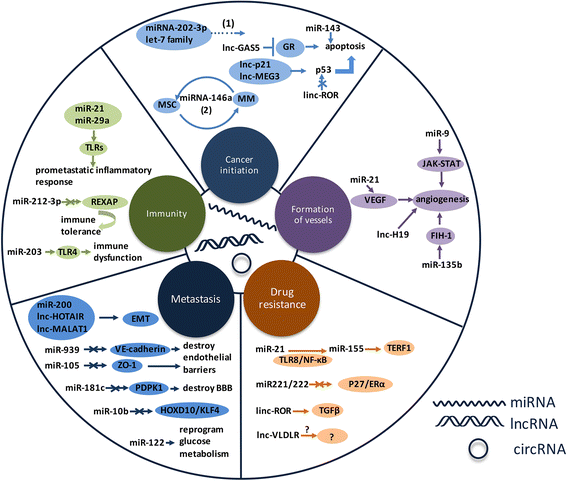Extracellular vesicles-mediated noncoding RNAs transfer in cancer
- PMID: 28231804
- PMCID: PMC5324273
- DOI: 10.1186/s13045-017-0426-y
Extracellular vesicles-mediated noncoding RNAs transfer in cancer
Abstract
Extracellular vesicles (EVs) are small membranous vesicles secreted from numerous cell types and have been found involved in cell-to-cell communication by transferring noncoding RNAs (ncRNAs) including microRNAs, long noncoding RNAs, and circular RNAs. Emerging evidence shows that EV-associated ncRNAs play important roles in a wide range of diseases, particularly in cancer where they function through regulating protein expression of the pivotal genes that make contributions to tumorigenesis. Given their stability and abundance in serum, EV-associated ncRNAs can act as new diagnostic biomarkers and new therapeutic targets for cancer. Herein, we review the properties of EV-associated ncRNAs, their functions, and potential significance in cancer.
Keywords: Cancer; Extracellular vesicles; Mechanism; Noncoding RNAs.
Figures

Similar articles
-
Noncoding RNAs of Extracellular Vesicles in Tumor Angiogenesis: From Biological Functions to Clinical Significance.Cells. 2022 Mar 10;11(6):947. doi: 10.3390/cells11060947. Cells. 2022. PMID: 35326397 Free PMC article. Review.
-
The role of exosomal noncoding RNAs in cancer.Mol Cancer. 2019 Mar 9;18(1):37. doi: 10.1186/s12943-019-0984-4. Mol Cancer. 2019. PMID: 30849983 Free PMC article. Review.
-
Extracellular Vesicles as Delivery Vehicles for Non-Coding RNAs: Potential Biomarkers for Chronic Liver Diseases.Biomolecules. 2024 Feb 26;14(3):277. doi: 10.3390/biom14030277. Biomolecules. 2024. PMID: 38540698 Free PMC article. Review.
-
The role of tumor-derived extracellular vesicles containing noncoding RNAs in mediating immune cell function and its implications from bench to bedside.Pharmacol Res. 2023 May;191:106756. doi: 10.1016/j.phrs.2023.106756. Epub 2023 Apr 3. Pharmacol Res. 2023. PMID: 37019192 Review.
-
Emerging roles of extracellular vesicle-associated non-coding RNAs in hypoxia: Insights from cancer, myocardial infarction and ischemic stroke.Theranostics. 2022 Jul 18;12(13):5776-5802. doi: 10.7150/thno.73931. eCollection 2022. Theranostics. 2022. PMID: 35966580 Free PMC article. Review.
Cited by
-
Exploring the potential of the convergence between extracellular vesicles and CAR technology as a novel immunotherapy approach.J Extracell Biol. 2024 Sep 26;3(9):e70011. doi: 10.1002/jex2.70011. eCollection 2024 Sep. J Extracell Biol. 2024. PMID: 39328262 Free PMC article. Review.
-
The silencing of miR-199a-5p protects the articular cartilage through MAPK4 in osteoarthritis.Ann Transl Med. 2022 May;10(10):601. doi: 10.21037/atm-22-2057. Ann Transl Med. 2022. PMID: 35722355 Free PMC article.
-
circRNA circAF4 functions as an oncogene to regulate MLL-AF4 fusion protein expression and inhibit MLL leukemia progression.J Hematol Oncol. 2019 Oct 17;12(1):103. doi: 10.1186/s13045-019-0800-z. J Hematol Oncol. 2019. PMID: 31623653 Free PMC article.
-
The role of exosomal PD-L1 in tumor progression and immunotherapy.Mol Cancer. 2019 Oct 23;18(1):146. doi: 10.1186/s12943-019-1074-3. Mol Cancer. 2019. PMID: 31647023 Free PMC article. Review.
-
The decade of exosomal long RNA species: an emerging cancer antagonist.Mol Cancer. 2018 Mar 20;17(1):75. doi: 10.1186/s12943-018-0823-z. Mol Cancer. 2018. PMID: 29558960 Free PMC article. Review.
References
Publication types
MeSH terms
Substances
LinkOut - more resources
Full Text Sources
Other Literature Sources

